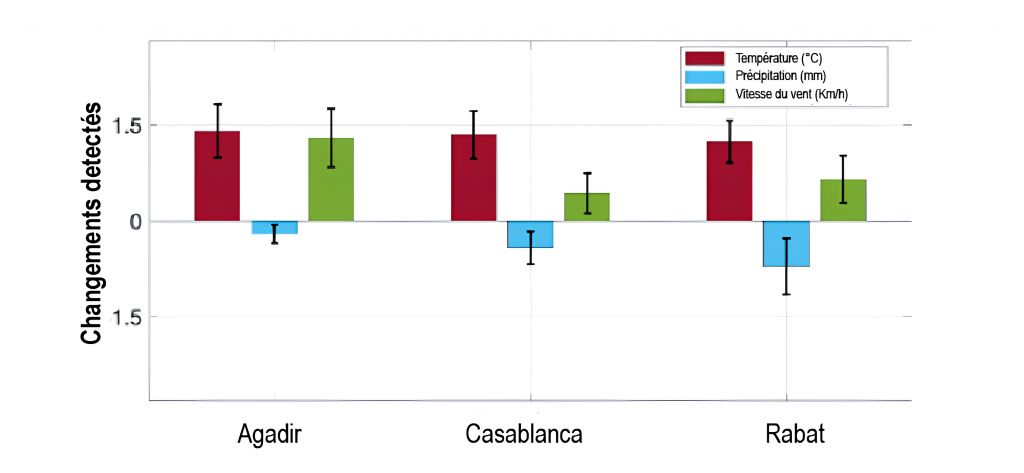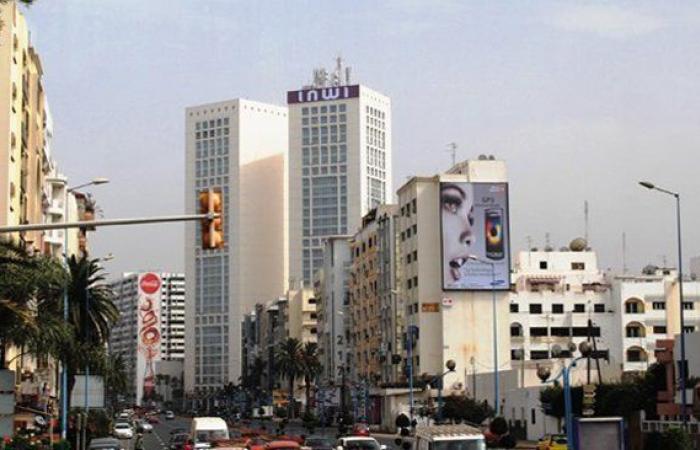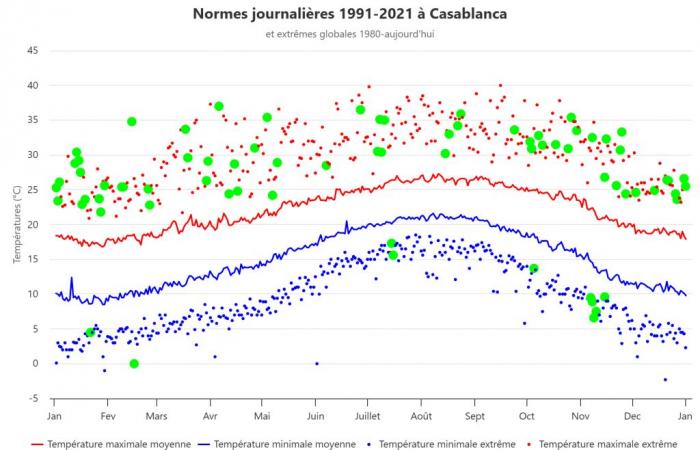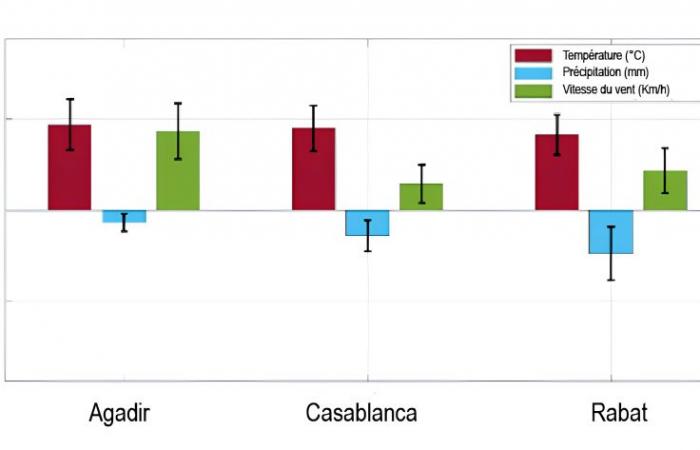JavaScript is disabled! Why you want to do so? Please enable JavaScript in your web browser!
In Morocco, global warming is a reality which is growing and which is manifested in particular by an incomprehensible increase in temperatures, the scarcity of precipitation, the reduction in surface water resources and a direct impact on agricultural activity.
While we are in the middle of autumn, a new heat wave is raging across the entire Atlantic plain, with maximums of 33 degrees recorded in Casablanca, El Jadida and Agadir, a few weeks before the arrival of winter.
Winter temperatures in Morocco, usually below 20°Cwere disrupted in 2024 by successive episodes of heat.
Casablanca, like other cities in the country, has experienced temperatures repeatedly exceeding the threshold of 30 degrees, a completely abnormal climatic phenomenon in this season.
The climate hotspots of the economic capital
In urban areas, rising temperatures are felt more strongly in certain areas than others. This physical phenomenon, characterized by the formation of a thermal dome, leads to a local increase in temperature (an increase of more than 6 degrees compared to normal areas).
Several factors contribute to the intensification of these heat islands, including the concentration of buildings, pollution, lack of vegetation, lack of overhead ventilation, and the dominance of impermeable surfaces such as asphalt or concrete. Coupled with the effect of humidity, the phenomenon of urban heat islands makes heatwave episodes particularly difficult to live with for the people of Casablanca.
On the other hand, the islands of freshness (a decrease of up to 6 degrees compared to normal areas), characterized by abundant vegetation, good air circulation, low urban density and less vehicle traffic, can mitigate the effects of global warming in urban areas . These spaces, by creating shade, cooling the air by evapotranspiration and absorbing CO2, constitute real shields, the frequency and intensity of which should increase with the accentuation of global warming.
Urban heat islands represent a major public health risk, because in addition to causing common heat-related illnesses (dehydration, fever, respiratory problems, etc.), they can amplify the risk of chronic illnesses such as kidney disease, diabetes and cardiovascular diseases.
Below, a map showing the distribution of ground temperatures, as well as the location of heat and cool islands in the city of Casablanca, reconstructed by Médias24 from satellite data taken on November 23, 2024 at 11 a.m. (GMT+ 1) [carte interactive].
Analysis of the Heatmap of November 23, 2024, the day when Casablanca reached 30°C, reveals the presence of several heat islands, with temperatures peaking at 38°Cmainly concentrated in the north of the city, in industrial zones, dense neighborhoods and bare land.
Conversely, the islands of freshness are located in the district ofAnfacharacterized by abundant vegetation, reduced traffic and lower built density.
2024, a year that defies all statistics
During this exceptional year, Morocco experienced a record number of heat waves, making this phenomenon a norm rather than an exception.
On April 5, Casablanca, usually cooled by the trade winds, recorded a historic heat record of 37 °Ca temperature well above seasonal averages and closer to summer temperatures typical of inland and desert regions.
Three main heat waves, 6-7, 23-24 and 27-28 in November add to the series of hot episodes we have experienced this year.
With 33.3°C on November 24, Casablanca came particularly close to the record of 34.7°C recorded 40 years ago, in 1984.
Like Casablanca, other Atlantic coastal cities broke their temperature records in November, including Agadir at 37.4°C, Rabat at 34°C, Mohammedia at 33.4°C, Essaouira at 31.3 °C and Kenitra at 32.5°C.
According to the General Directorate of National Meteorology, regions of the Atlantic plain, such as Casablanca, Rabat and Mohammedia, experienced notable deviations ranging from +8 to +10 degreescompared to ten-year averages. Although these temperature increases can occur at this time of year, the magnitude and recurrence of this increase is unusual as was the case on November 16, 2009 when a temperature was recorded at 31.3°C.
The DGM explains that this exceptional heat wave is due to an anticyclone over northern Africa which pushed masses of hot air towards Morocco. It is part of a broader context of global climate disruption, which is increasing extreme weather events such as unusual heat waves, even during periods when temperatures are normally lower.
A previous interpretation of Climameteran observatory specializing in the analysis of extreme climatic events, following the heat wave of February 2024, agrees with the conclusions of the DGM concerning the causes of the recurrence of these heat waves.
According to these scientists, anthropogenic climate change is a determining factor. They also point out that changes in atmospheric pressure systems, with a drop over southern Spain and Portugal and an increase over the Atlantic, favored this event. Furthermore, they note that similar episodes tend to occur from February to March.

According to the assessments of these scientists, temperatures over a large part of Morocco have seen an increase of 1 to 2°C compared to seasonal averages. This trend is particularly marked in large urban areas such as Agadir, Casablanca and Rabat, where temperatures have increased by around 1.5°C.
As a result, Moroccan cities are expected to experience an increase in the number of days with maximum temperatures above 35°C, potentially reaching 50 to 100 days by 2050 according to the latest IPCC modeling.
Making territories resilient to the effects of global warming
To face the challenges of global warming, it is essential to rethink our cities. By moving from a logic of isolated actions to a systemic approach, we can generate islands of coolness which will help mitigate the sudden effects of global warming. First, urban greening, through the planting of trees, green roofs and the creation of green spaces, is a key solution for refreshing environments while improving air quality.
At the same time, the construction of energy-efficient buildings, the encouragement of sustainable transport and the adoption of renewable energy solutions make it possible to significantly reduce energy consumption, greenhouse gas emissions and atmospheric and noise pollution, thus improving the quality of life of the inhabitants.
By acting on these different levers, it is possible to create more resilient cities in the face of climate change and to promote sustainable urban development, as targeted by the new development model (Strategic Axis 4: resilient territories, anchoring places development).
Do you have a real estate project in mind? Yakeey & Médias24 help you make it happen!
© Media24. Any reproduction prohibited, in any form whatsoever, without written authorization from the Société des Nouveaux Médias. This content is protected by law and in particular law 88-13 relating to the press and publishing as well as laws 66.19 and 2-00 relating to copyright and related rights.








